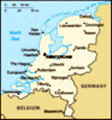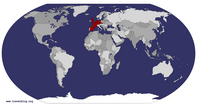Advertisement
Published: February 4th 2011
***www.thetattooedtraveler.com***
When you say the name “Amsterdam,” the response is Pavlovian: pot and prostitutes. Before leaving, I received a veritable laundry list of “the best” coffeeshops from friends who have been. One of my students who has Dutch ancestry and has been there many times warned me not to go into coffeeshops because “they’re for drugs.” Do people go to Amsterdam for anything else? I did, and I was determined to discover what else the original “Sin City” had to offer.
I’ve heard that Amsterdam is the most culturally diverse city in the world. Although I’ve done some searching, I haven’t been able to discover any research to back that claim. Once you arrive, however, you quickly realize that if it’s not the most diverse, it certainly is a contender. In fact, there’s so much cultural variety that it can be difficult to find much that’s traditionally Dutch, though I did manage to find a few absolute gems.
We’ll start where my heart lies: beer. There’s the Heineken Experience brewery tour and tasting. However, I want flavor when I drink beer, and it took little more than a Google search for me to find two
great little breweries right in the heart of Amsterdam.
We started at Brouwerij de Prael (www.deprael.nl), in the center of Amsterdam on Warmoesstraat, just north of Dam Square. We were looking for a place to watch the Netherlands World Cup match against Brazil, and since I’d wanted to try this place, we decided there was no time like the present. It was the perfect place to watch the game, not crazy or packed. We got seats, the beers were €2 for a small (20 ml) glass, and they brought hors d’oeuvers around for everyone. The owners were sitting right in front of us and we quickly realized most of the people there knew each other. Regardless, they were extremely friendly to outsiders— though it didn’t hurt that we rooted for the Netherlands. The beer was outstanding! Dutch beer is similar to Belgian beer, strong and flavorful. Brouwerij de Prael names all their beers after Dutch pop singers from the ‘60’s and ‘70’s, so you can have a glass of Heintje, Willeke, Nelis, Johnny, or André. Everyone got a round on the house when the final whistle blew. It was so much fun to be with Dutch fans as
they watched their national team beat one of the world’s best. I highly recommend this place if you’re going to Amsterdam— the beer is great and the people are absolutely terrific!
The other Brewery is called Brouwerij ‘t IJ. It’s a little farther outside of town, but easily accessible by tram (Hoogte Kadijk stop on the #10 line). Public transportation in Amsterdam is very user friendly and you can buy tickets right on the tram. We arrived at the brewery around 2pm (about an hour before they opened) and by 3pm a crowd had gathered. Any place that’s open for seven hours every day and still has a horde of people waiting to get in has got to be good. Once the initial line died down there was very little wait to get a beer. The beers were strong and very flavorful with light and dark options— again, very Belgian-like. The following styles are brewed year round and are available on tap: Pilsner (Plzen), White (Witt), Double Trappist-Style (Natte), Triple Trappist-Style (Zatte), and a dark beer (Struis)— each an excellent representative of it’s particular style.
Before we went to Brouwerij ‘t IJ, we spent the morning
at the Rijksmuseum (www.rijksmuseum.nl). The museum is currently undergoing renovation, so the permanent exhibit was limited compared to normal, but the €12.50 admission fee was well worth it— it’s a “must see” museum in Europe. The Dutch Masters (not a pot reference) are obviously well represented— Rembrandt and Vermeer stand out among them. Portraits and landscapes dominate the subject matter, with portraits being far more interesting (in my humble opinion). The floor plan takes you from room to room without having to double back and culminates with Rembrandt’s Night Watch— the most famous piece in the museum and Rembrandt’s masterpiece. As it should be, the Rijksmuseum does not allow photography— the experience must be savored instead of captured. The building itself is also quite spectacular, from what little I saw poking through the scaffolding.
I’d say the place to get a drink on a nice day in Amsterdam is Café de Jaren (www.cafedejaren.nl). Lofty ceilings, large windows, and wide-open spaces compliment the modern décor. The best seat in the house is outside, next to the canal. Sit in the sunshine or under an umbrella and watch the ducks and boaters cruise by, but beware, the Speedo is still
alive and well in Europe. The outdoor seating fills up fast with little turnover, so get there early or grab a table by an open window. The beer menu is pretty standard for Amsterdam bars— nothing noteworthy, but not bad either. This place is more about ambiance than anything else.
My food experiences were pretty much all worthwhile. The first night we ate at Aneka Rasa Indonesian restaurant (on Warmoesstraat just north of Dam Square). I’ve read mixed reviews, though my experience was excellent— good food, friendly and attentive service, and reasonably priced. We had lamb satay, spring rolls, and a mixture of lamb, egg, and scallions wrapped in flaky pastry and deep-fried— all solid choices.
We followed that up the next night at Tasty Asia, which may have been a chain, but you couldn’t tell from the quality and flavor of the food. It had been a long day and most places were packed with drunken people celebrating Oranje’s big win over Brazil. We just wanted a quiet place to eat, but ended up being pleasantly surprised by the food. I got fried noodles with pork in a spicy Kong Po sauce for about €6—
large portions, good quality, and lots of flavor for a good price. That and a couple of extra large beers set me straight and put a bow on my day.
The third night we had Malaysian food at a place called WAU, located on Zeedjik. I was excited because I had never had Malaysian food, and while that may be like coming to New York for Chinese or Sushi, I really didn’t care. We had meat satay, which consisted of chicken, lamb, goat, and beef skewered and grilled. The chicken was a little overcooked and dry but the rest of the meat was excellent and very tasty. The satay came with a spicy peanut sauce that was neither necessary nor very good (it tasted like spicy peanut butter). We followed up with mussels in an extra-spicy sauce that was flavorful with just the right amount of heat. The meal was very enjoyable, even if the tables were a little too close together.
Döner is as good a late-night drunk food as I’ve had anywhere! There’s pizza in NYC and Döner in Europe— SO freakin’ good! Shaved mystery mean in a pita with a cole-slaw-like substance (minus the mayo), tahini sauce, and some spicy sauce (optional) that was just as tasty as can be.
We had breakfast the first day at a place called Lanskroon (www.lanskroon.nl). It’s a small Dutch bakery and café frequented by locals. I had a tasty and wonderfully flaky ham and cheese croissant, a latté, and fresh-squeezed orange juice. The second day we ate breakfast at Kwekkeboom in the shopping section near Rembrandtplein. Like the name “Quickie-boom” might imply, it did the trick, but wasn’t very satisfying— it wasn’t actually bad, it was just touristy, more expensive, and not as good as Lanskroon. The last day we sat outside by a canal and ate breakfast at the Pancake Bakery (www.pancake.nl). This isn’t your typical American pancake, and it’s difficult to describe—not fluffy, more egg-like, but not like an omelet; it wasn’t sweet, so you could add anything to it— such as ham and cheese or banana and Nutella (I had the latter).
Some sights to see:
• Westerkerk is much more impressive from the outside than from the inside. Its spire, soaring above the canals, is an often-depicted sight in Amsterdam. It’s free to get in, so you might as well, but there’s nothing but an enormous organ to see.
• Oudekerk costs €5 to get in, but it’s worth it for the stained glass windows and beautiful woodwork. The bright and beautiful windows look like Renaissance paintings with vibrant color and perfect perspective.
The Anne Frank House is the saddest place I have ever been in my life. I had to fight back tears several times as I walked through the rooms where the Frank family and their friends hid out for over two years. Blackout curtains have been kept in place so visitors get an idea of what everyday life was like without sunshine. You get a sense of the frustration of being cooped up with no privacy, the longing to be able to lead a normal life, and the constant fear of discovery— but whatever sense you get can’t even come close to what they must have felt. Otto Frank (Anne’s father) was the only person, of the eight living in the annex, to survive the concentration camps. Anne died of typhus at Bergen-Belsen in 1945, just one month before it was liberated. I don’t know how Otto Frank went on after that, though maybe dedicating his life to Anne’s diary, the museum in the annex, and the memory of his family and friends gave him a purpose and resolve. On a practical note, there’s an enormous line to get into the museum all day long, so either buy tickets online in advance or avoid peak hours. The Anne Frank House is something that everyone really should see.
Amsterdam is a city rich in history and culture, witness to economic boom and the atrocities of war. The architecture of the canal houses and the canals themselves are beautiful and serene. There’s a tradition of incredible fine art and an influx of culinary delights from around the world. Oh yeah, it’s also legal to smoke pot and solicit prostitutes, but if that’s all you’re seeing, you’re not seeing Amsterdam!
Advertisement
Tot: 0.046s; Tpl: 0.011s; cc: 12; qc: 27; dbt: 0.0265s; 1; m:domysql w:travelblog (10.17.0.13); sld: 1;
; mem: 1.1mb









